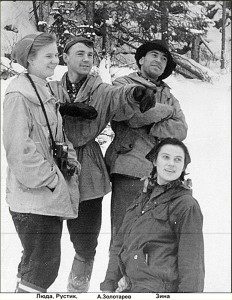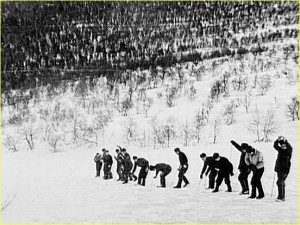 In the world of UFOlogy and Cryptozoology few characters are as spooky and memorable as those associated with the Derenberger incident. And while many people may be unfamiliar with the case itself, the characters involved are infamous, both among paranormal circles and in popular culture.
In the world of UFOlogy and Cryptozoology few characters are as spooky and memorable as those associated with the Derenberger incident. And while many people may be unfamiliar with the case itself, the characters involved are infamous, both among paranormal circles and in popular culture.
The story of Woodrow Derenberger, a salesman for a small sewing machine company, has been told many times – most notably in the book he coauthored with Harold W. Hubbard called Visitors from Lanulos[1], which chronicled this strange tale.
It began on November 2, 1966, Derenberger was returning from a trip to Marietta, Ohio on his way home to Mineralwells, West Virginia (also Mineral Wells). Derenberger was travelling alone, driving along interstate 77 near Parkersburg, West Virginia, when he was suddenly overtaken by another vehicle. This vehicle, which Derenberger described as the strangest thing he’d ever seen, claiming it resembled a huge “kerosene lamp”, passed by Denereberger’s truck and turned sideways, blocking both lanes of the highway, causing both vehicles to come to a complete stop.
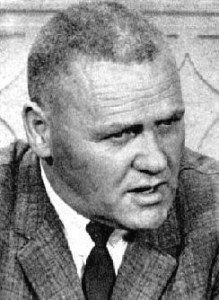
Stunned, Derenberger watched as a man emerged from the strange vehicle. The dark suited and oddly grinning man approached Derenberger’s door as the strange vehicle lifted off the ground and floated to about 40 feet off the ground.
The man communicated with Derenberger through some form of telepathy, and identified himself as a seeker. He asked Derenberger who he was and then told the frightened salesman that his name was Cold. Cold asked several questions of Derenberger, some pertaining to the nearby town of Parkersburg, and after a short while, he ended the conversation by saying “It’s been nice talking to you Mr. Derenberger. We will be seeing you again.” And with that, Cold stepped away from the truck, at which point his strange vehicle returned to the roadway, and shooting off into the sky, he left the bewildered man sitting alone on the highway.
Just ten days later, the now famous events of the Mothman Incidents in Point Pleasant, West Virginia began, which apparently culminated in the collapse of the Silver Bridge in Point Pleasant, killing 46 people. As has been popularised by Mark Pellington’s 2002 thriller The Mothman Prophecies staring Richard Gere and based on John Keele’s book of the same name, Indrid Cold was a key figure in those events. Connecting that Cold with the one in Derenberger’s version, some suggest that Cold was (or is) a member of the elusive and mysterious Men In Black, while others believe he is an alien or inter-dimensional being.
 But his story doesn’t end there, and neither does Woodrow Derenberger’s. Following the events of Point Pleasant, Derenberger made claims that Cold had admitted, through continued telepathic contact, that he was an alien from a planet called Lanulos within the galaxy known as Genemedes (both of which seem to be fictional). More than that, however, Derenberger claimed that Cold had actually taken him to Lanulos in a spaceship, where Derenberger claimed to have seen many other Lanulosians and relayed some commentary on their culture. Over the years, according to Derenberger, Cold was joined on earth by two other Lanulosians, named Demo Hassan and Karl Ardo, both of whom were apparently more discreet than Cold ever was.
But his story doesn’t end there, and neither does Woodrow Derenberger’s. Following the events of Point Pleasant, Derenberger made claims that Cold had admitted, through continued telepathic contact, that he was an alien from a planet called Lanulos within the galaxy known as Genemedes (both of which seem to be fictional). More than that, however, Derenberger claimed that Cold had actually taken him to Lanulos in a spaceship, where Derenberger claimed to have seen many other Lanulosians and relayed some commentary on their culture. Over the years, according to Derenberger, Cold was joined on earth by two other Lanulosians, named Demo Hassan and Karl Ardo, both of whom were apparently more discreet than Cold ever was.
Wild as this may seem, some believe that these events are corroborated by their connection to another terrifying paranormal phenomenon: The Grinning Man. First mentioned by paranormal researcher and author John Keele (yes the same man who wrote Mothman Prophecies), in his seminal work The Complete Guide to Mysterious Beings[2], the Grinning Man, or men as the case may be, is a strange and rather large man who, like the name suggests, grins, and scares the bejesus out of those who see him.
 Keele believed that the first ever encounter with The Grinning Man occurred in Elizabeth, New Jersey on October 11, 1966, less than a month before Derenberger’s encounter. On that night two young boys, Martin Munov and James Yanchitis were walking home along a road that ran adjacent to the elevated New Jersey Turnpike. As they walked along the dark street, Yanchitis noticed a strange looking man standing in the darkness at the top of the treacherous incline, trapped by a chain link fence. Upon calling out to Munov, the boys watched as the figure slowly turned to face them with an unnerving ear to ear grin.
Keele believed that the first ever encounter with The Grinning Man occurred in Elizabeth, New Jersey on October 11, 1966, less than a month before Derenberger’s encounter. On that night two young boys, Martin Munov and James Yanchitis were walking home along a road that ran adjacent to the elevated New Jersey Turnpike. As they walked along the dark street, Yanchitis noticed a strange looking man standing in the darkness at the top of the treacherous incline, trapped by a chain link fence. Upon calling out to Munov, the boys watched as the figure slowly turned to face them with an unnerving ear to ear grin.
The boys described the being as taller than six foot two inches (referencing one of the investigators of the case, the famous actor Chuck McCann, who was a rather large individual) and very broad. They said that they saw no facial features other than the creature’s beady eyes and its wide toothy grin. They also noticed that the being was wearing a kind of shimmery green jumpsuit or overalls.
Munov and Yanchitis’ story was documented by the police, the press and by Keele and his team of investigators, and other accounts of a strange tall, grinning man began to come in from all around the area. Keele connected this Grinning Man encounter with an alleged UFO sighting that occurred at the same time some 40 miles north of Elizabeth, near the DuPont explosives factory outside Pompton Lakes, New Jersey. Those familiar with the Mothman incident will note that there were several Mothman sightings in an area of Point Pleasant known as the “TNT area”, which had been a munitions manufacturing and storage area previously.
As with many stories of this nature, the connections between incidents are tenuous at times and some point out that since Keele was almost exclusively the only one to document these cases, he may have used poetic license in his tellings of the stories, drawing connections where they might not have existed in reality. Because of the relatively close proximity of the encounters and the timeframe in question, many believe that Keele was justified in his speculation that the Grinning Man and Indrid Cold were one and the same. Cold’s apparently prophetic involvement in the Point Pleasant disaster paints a picture of the creature, or whatever you might call him, as something to be feared, and if the Grinning Man encounters are indeed connected to Indrid Cold, perhaps there’s something to be said for that hypothesis. But Woodrow Derenberger’s accounting suggests that Cold and his associates are/were simply curious travellers.
Unfortunately, there have been no modern sightings, of Cold or the Grinning Man, so if there is any thread of truth weaved through this story it is likely to remain hidden into the foreseeable future. The stories of Indrid Cold and the Derenberger Incident are favourites of many in the paranormal community, and much speculation has been focused on these reports. Really the only source materials available are Keele and Derenberger’s books, but that doesn’t mean that there aren’t many tellings of the stories online. Anyone looking for more information can easily find it with a simple search.
[1] Derenberger, Woodrow. Visitors from Lanulos. Vantage Press (1971)
[2] Keele, John. The Complete Guide to Mysterious Beings. Tor Books (2002). ISBN-10: 0765345862 Chapter 14. http://galaksija.com/literatura/guide.pdf




 Some try to frame their hypotheses in the language of science, of physics, such as the Quantum Theory of Ghosts developed by Max Bruin PhD., which says that ghosts are “an impression upon the subatomic weave of the universe, created via strong emotion of a sentient observer.”
Some try to frame their hypotheses in the language of science, of physics, such as the Quantum Theory of Ghosts developed by Max Bruin PhD., which says that ghosts are “an impression upon the subatomic weave of the universe, created via strong emotion of a sentient observer.”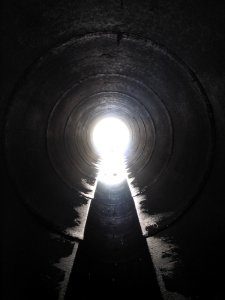 Recent discussion on the existence of the soul and the ramifications of a conclusion in either direction – such as you can find
Recent discussion on the existence of the soul and the ramifications of a conclusion in either direction – such as you can find  László isn’t alone in this line of thought however. Laid out in his 1994 book, Shadows of the Mind,
László isn’t alone in this line of thought however. Laid out in his 1994 book, Shadows of the Mind, It turns out though, that wave function collapse doesn’t explain the process, at least according to Swedish-American physicist and cosmologist Max Tegmark. Tegmark argued in his 2000 paper in the journal Physical Review E, that wave function collapse would occur at too fast a rate for it to have any impact on neural processes.
It turns out though, that wave function collapse doesn’t explain the process, at least according to Swedish-American physicist and cosmologist Max Tegmark. Tegmark argued in his 2000 paper in the journal Physical Review E, that wave function collapse would occur at too fast a rate for it to have any impact on neural processes.











 How would you react to seeing an exact duplicate of someone you love? Would you be able to tell which was which? Who is the real one and who is the…imposter?
How would you react to seeing an exact duplicate of someone you love? Would you be able to tell which was which? Who is the real one and who is the…imposter?
 Other famous accounts of Doppelgänger encounters, like that of Johann Wolfgang von Goethe and even Abraham Lincoln – who saw himself in a mirror sporting two faces
Other famous accounts of Doppelgänger encounters, like that of Johann Wolfgang von Goethe and even Abraham Lincoln – who saw himself in a mirror sporting two faces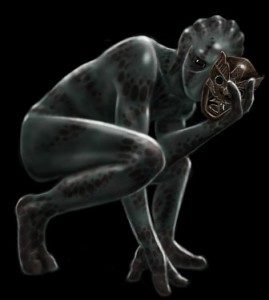 Interestingly, the many-worlds theory of quantum physics, or the many-worlds interpretation may actually support this idea. The many-worlds theory says that through universal wavefunction, all possible histories and futures exist simultaneously. This is different from the multiverse theory, as the latter is the assertion that outside of our physical universe exist many other universes, possibly with differing laws of physics.
Interestingly, the many-worlds theory of quantum physics, or the many-worlds interpretation may actually support this idea. The many-worlds theory says that through universal wavefunction, all possible histories and futures exist simultaneously. This is different from the multiverse theory, as the latter is the assertion that outside of our physical universe exist many other universes, possibly with differing laws of physics.